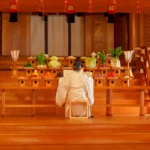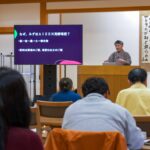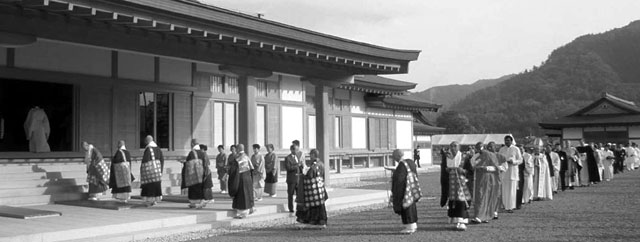
The Dream of the Choseiden
In 1934, Onisaburo Deguchi laid the foundation stone for a building called the Choseiden on top of Tsuruyama Hill in Ayabe. Crowning Oomoto’s most sacred site, this building was designed to be a place of worship not only for Oomoto but for all religions. Destroyed after 1935 in the Second Oomoto Incident, the Choseiden waited fifty years to be rebuilt. Onisaburo had predicted that when completed, the Choseiden would draw together leaders from all the world’s religions.
On November 6, 1992, Oomoto at last finished constructing the new Choseiden. This work, using traditional shrine carpenters and precious ancient wooden timbers, had taken nearly twenty years. It is said that the Choseiden will be the last large-scale structure ever built in Japan in pure Japanese style.
Prayer and Forum at Ayabe
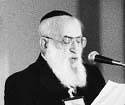
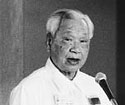
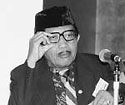
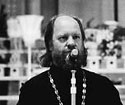
True to Onisaburo’s prediction, the Choseiden was the site of a true gathering of world religious leaders on November 4 and 5, 1993. Representatives from Islam, Judaism, Christianity (Roman Catholic, Episcopalian, Russian Orthodox), sects of Theravada and Mahayana Buddhism, Hinduism, Shinto, Japanese New Religions, Chinese Tao Yüan, Vietnamese Cao Dai, and others gathered at the Choseiden for the Prayer and World Religious Forum sponsored by Oomoto.
Among the participants was Oomoto’s old friend Dean Morton of the Cathedral of St. John the Divine in New York. Rev. Giao Huu came from California representing the renascent Cao Dai religion of Vietnam, a universalist religion linked to Oomoto as long ago as 1930. On the Japanese side, the supporters of the Forum included H. E. Eiji Shirai, President of the Association of Shinto Shrines, Most Ven. Niwano Nikkyo, Founder of Rissho Koseikai, Most Ven. Etai Yamada, Patriarch of Tendai Buddhism and others.
A Different Type of Conference
The Prayer and Forum at Ayabe marked a new type of religious gathering, for several reasons. The event was held not in a modern conference hall, but inside the cedar and tatami matted interior of the Choseiden. The emphasis was on sharing of religious ritual rather than only conference talk. Finally, the impetus for this meeting arose in East Asia, not Europe or America, signifying a new era for inter-religious work.

